Powerlifting vs. Bodybuilding: Pros, Cons, Key Differences
Written by The Boostcamp Editors
The pros, cons, and differences of powerlifting vs. bodybuilding
Powerlifting and bodybuilding are some of the most common goals when it comes to someone joining a gym, as many people want to put on strength or size, or both. But while these two training styles have plenty of similarities, there are some significant differences between the two sports. If you’re interested in starting a workout training routine, understanding these differences can help you determine which type of program will suit you best based on your goals and training preferences, whether that be powerlifting or bodybuilding that you are looking to train for.
In this article, we will discuss:
An overview of powerlifting and its benefits and drawbacks
An overview of bodybuilding and its benefits and drawbacks
The differences between powerlifting and bodybuilding
How to choose between powerlifting vs. bodybuilding programs
The best powerlifting and bodybuilding programs available in the Boostcamp app
Let's dive into powerlifting vs. bodybuilding.
What Is Powerlifting?
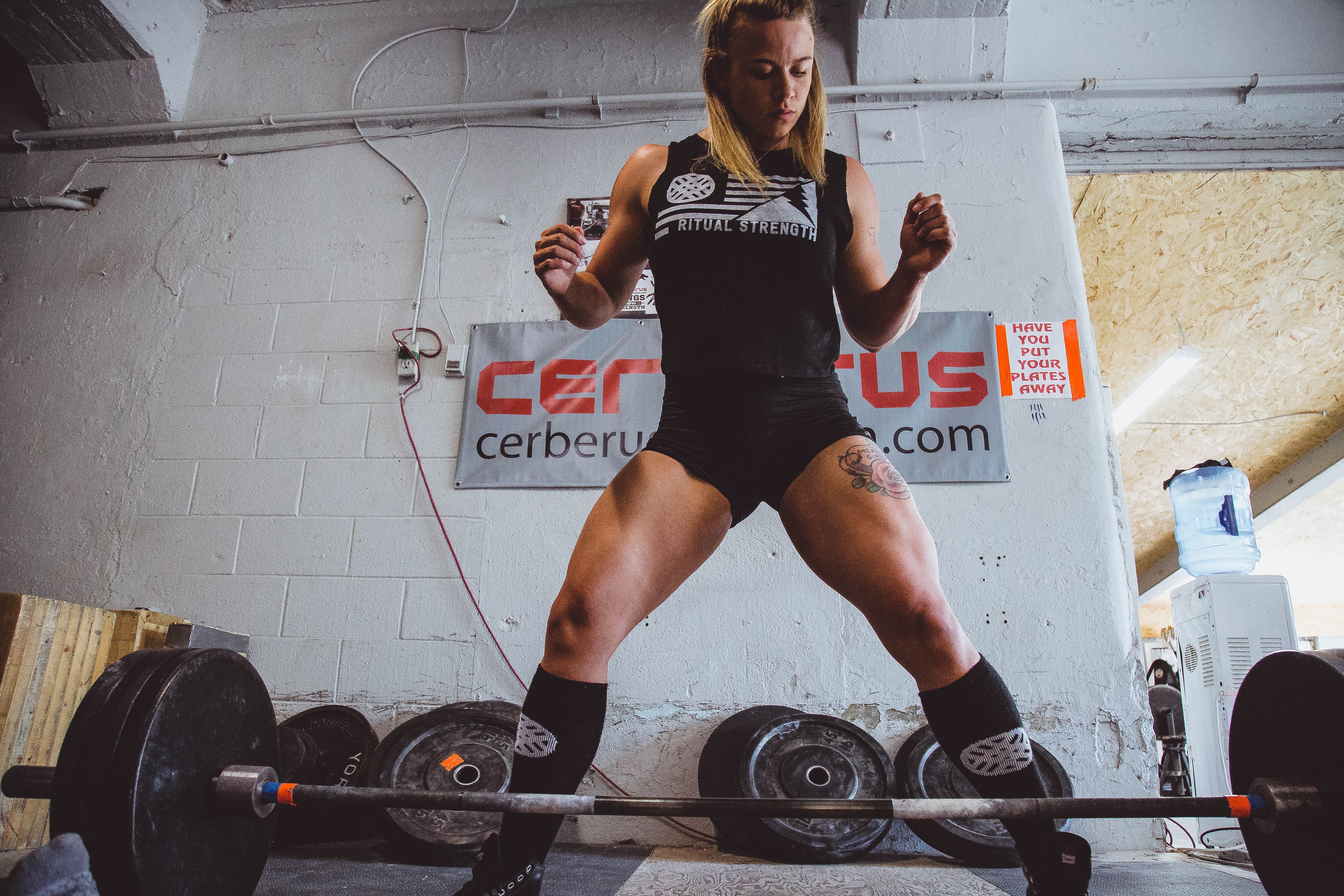
Powerlifting is a strength sport in which lifters aim to get stronger in the big three compound lifts that consist of the barbell squat, the barbell bench press, and of course, the deadlift. In powerlifting meets, lifters are categorized into different weight classes and age groups and get three attempts to lift a pre-determined amount of weight for each movement.
At the end of a meet, the athlete’s highest successful attempts in each lift are added together to form a total. So if a lifter’s highest successful attempts were a 200 kg back squat, 110 kg bench press, and 250 kg deadlift, his total would be 560 kg (1,232 lbs).
Benefits of Powerlifting
Powerlifting Increases Muscle Mass
Even though the goal of powerlifting isn’t to get “shredded” or become insanely bulky and muscular, lifting like this does help build lean muscle mass. Lean muscle makes it easier to manage your weight because it helps your body burn more calories throughout the day. When you have more lean muscle, you also have an easier time maintaining a lower body fat percentage. A low body fat percentage (around 12-20% for men and 20-30% for women) helps prevent health conditions such as obesity, diabetes, and insulin resistance. (1)
Furthermore, lifting weights through powerlifting can help prevent sarcopenia (an age-related loss of muscle mass). This can help improve your quality of life and enable you to stay more independent as you age. (2)
Powerlifting Can Increase Self-Confidence
When you train for powerlifting, you often end up lifting weights you never thought you could. Seeing how strong your body can be can help increase your self-esteem. Setting and exceeding goals and overcoming the mental and physical challenges of powerlifting can also instill a sense of self-accomplishment that can help you feel better about yourself.
Powerlifting Strengthens Your Muscles
The squat, bench press, and deadlift are compound exercises that work multiple muscle groups. Squats and deadlifts work the lower body muscle groups, including the quads, the hamstrings, the glutes. Then to be a bit more specific, deadlifts work the entire posterior chain, such as the back muscles and the traps. Then you have the bench presses work the all of the pushing muscles such as the chest, shoulders, triceps, and, to a lesser degree, the biceps, upper back, and forearms.
Strengthening all of these muscles makes everyday activities such as climbing stairs and carrying heavy packages much easier. It also makes other physical activities, such as hiking, walking uphill, or playing sports, easier.
Heavy Lifts Increase Bone Density
In addition to increasing and maintaining muscle mass, powerlifting can aid bone preservation. Researchers believe this is because cells in the bones respond to mechanical loading (the physical stress placed upon your body when you lift weights) by eliciting bone formation. (3)
You Feel Like Part of a Community
The powerlifting community is supportive of beginner and advanced lifters alike. In powerlifting gyms, athletes spot each other, offer advice and guidance, and can motivate you when you’re struggling. Even in competition settings, it’s not uncommon for other athletes to offer encouragement and celebrate everyone else’s PRs.
These factors make powerlifting an excellent sport for those who like the social aspects of fitness.
Drawbacks of Powerlifting
Focusing Solely on Powerlifting Can Lead to Boredom or Weaknesses in Other Areas
To be a competitive powerlifter, you have to make powerlifting your primary area of focus. You may spend most of your time training for strength in the 1-5 rep range and base your workouts around the same three lifts. The lack of variety can become boring after some time. Powerlifters are also notorious for hating cardio. But not doing any cardio exercise can cause you to miss out on its benefits, such as improved blood flow and a stronger cardiovascular system. (4)
It Can Be Time-Consuming and Expensive
Powerlifting often requires you to train for at least an hour a day, if not more, several days per week. The time commitment can be hard to manage if you have a busy job and family responsibilities. Powerlifting is also an expensive sport. On top of a gym membership and/or coaching, you have to pay for gear like singlets, knee sleeves or wraps, lifting shoes, a lifting belt, and wrist wraps and wrist straps. You may purchase supplements like protein powder and creatine every few weeks. If you participate in non-local meets, you have to worry about travel expenses. You also typically have to pay an entry fee for meets.
Even though you likely won’t have to purchase lifting gear all that often, the other costs can still add up quickly.
There Is a Risk of Injury
The injury rate amongst powerlifters is low, but it’s not zero. Powerlifters are prone to lower back pain, knee pain, shoulder impingements, and muscle strains. These issues are generally due to overuse since powerlifters train variations of the squat, bench press, and deadlift so frequently, and are going pretty heavy on their sets more than likely.
However, there are ways to reduce your risk of injury. These include having someone spot you (particularly on the bench press and squat), lifting with proper technique, scheduling rest days and deload weeks to avoid overtraining, and varying your training intensity so that you’re not pushing maximal weights during every workout.
It Can Be Unhealthy
Some powerlifting federations test athletes for banned substances, but others don’t. Athletes who compete in non-tested federations may take performance-enhancing drugs to help them lift massive amounts of weight. However, steroid misuse can lead to issues such as high blood pressure, heart disease, and stroke. (5)
What Is Bodybuilding?
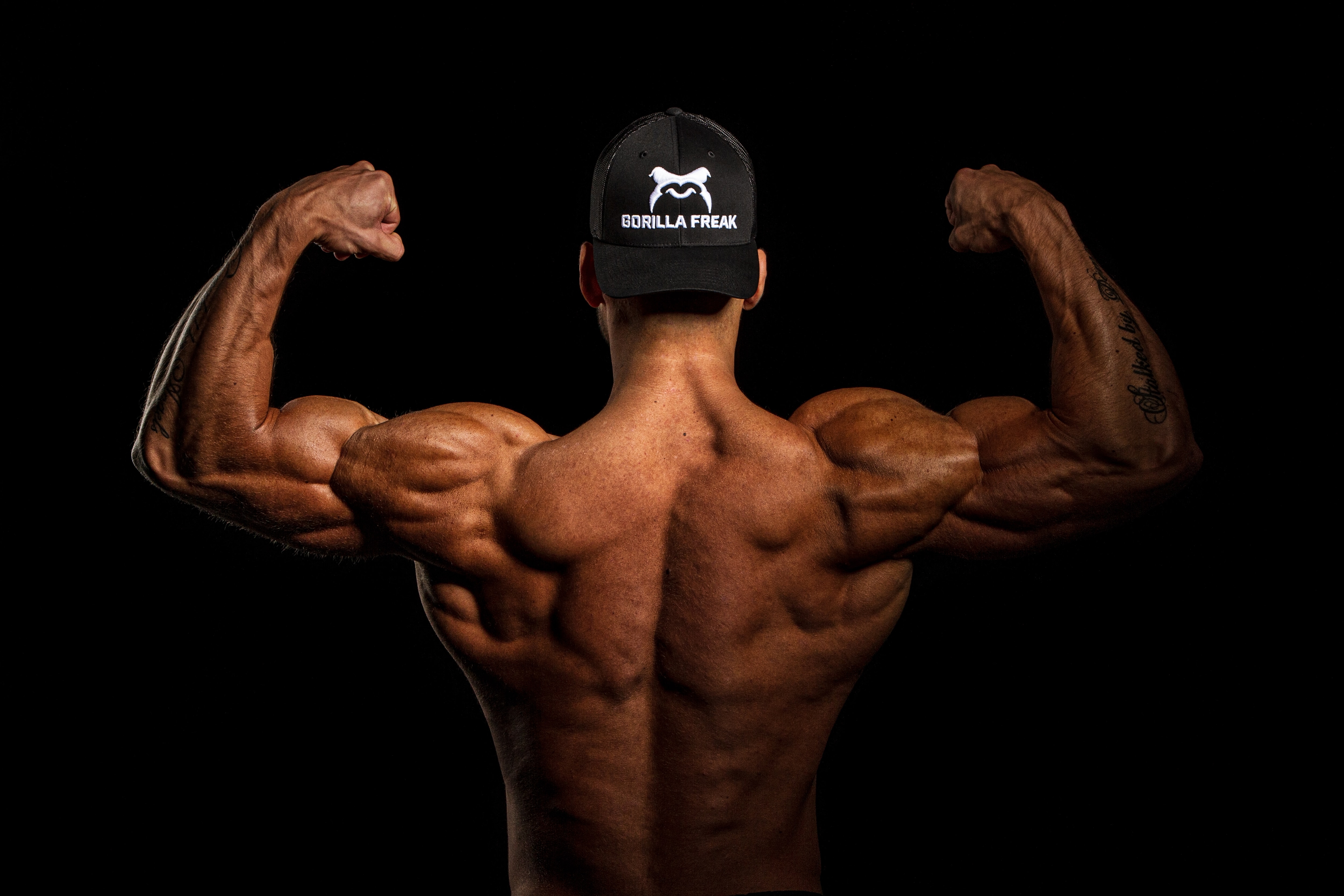
Bodybuilding is a sport in which judges evaluate athletes based on the size of their muscles and the symmetry of their physiques. Bodybuilders train for the purpose of building muscle and dropping to low body fat percentages to make that muscle more defined and visible.
Benefits of Bodybuilding
Many of the same benefits of powerlifting, including stronger muscles and increased lean muscle mass and bone density, apply to bodybuilding. The bodybuilding community can also be supportive if you surround yourself with knowledgeable coaches and fellow competitors who understand what you’re going through.
Like powerlifting, bodybuilding can also create a strong sense of self-accomplishment as you push past mental and physical barriers to become the best competitor you can be.
Drawbacks of Bodybuilding
Lack of Flexibility in Training and Dieting
Bodybuilders tend to be meticulous about their training and nutrition. They rarely miss a workout and eat specific amounts of protein, fat, and carbs each day. Bodybuilders may miss out on social events because they have to train or don’t want to be tempted by poor food choices.
Gaining Weight After a Show Can Cause Self-Esteem Issues
Bodybuilders are exceptionally lean when they step on stage for a bodybuilding contest. Their calories are low leading up to a show, and they may work out twice a day for a couple of hours each time. But that type of lifestyle isn’t maintainable year-round. Once they stop training as much and start eating more food, they gain weight again, which can cause self-esteem issues. This weight gain can cause them to feel unhappy or uncomfortable in their bodies after a bodybuilding contest.
It’s Expensive
Like powerlifting, bodybuilding is expensive. You may pay for separate coaches for training, nutrition, and posing. The suits can cost a few hundred dollars. You have to pay for tanning and makeup before your show. The cost of groceries and supplements can also add up.
Steroid Use is Prevalent
As with powerlifting, it’s not uncommon for bodybuilders to take performance-enhancing drugs. Not all athletes disclose this, though, which can cause new bodybuilders to have unrealistic expectations about the physiques they can achieve naturally.
Powerlifting vs. Bodybuilding: 7 Differences
Differences in Physique
When comparing bodybuilding vs. powerlifting, one of the most noticeable differences is the physique of each type of athlete. Bodybuilders must have low body fat percentages, well-defined muscles, and a symmetrical physique to be competitive and stand out from the other competitors on stage. Vascularity is also something many bodybuilders strive for, as it suggests high levels of conditioning.
The powerlifting physique is quite different. Powerlifters tend to have higher body fat percentages (though many are still within a healthy range) and less vascularity, and they don’t need to have a completely symmetrical appearance. They may still have a decent amount of muscle mass, but their muscles may not “pop” as much as a bodybuilder’s.
Different Divisions and Federations
Within powerlifting and bodybuilding, there are several divisions and federations in which athletes can compete.
Powerlifting Federations
Some of the most well-known powerlifting federations include the following:
100% Raw Powerlifting Federation
Global Powerlifting Committee (GPC)
Global Powerlifting Federation (GPF)
International Powerlifting Federation (IPF)
International Powerlifting League (IPL)
Natural Athlete Strength Association (NASA)
United States Powerlifting Association (USPA)
World Drug-Free Powerlifting Federation (WDFPF)
World Natural Powerlifting Federation (WNPF)
World Powerlifting Alliance (WPA)
World Powerlifting Congress (WPC)
World Powerlifting Federation (WPF)
World RAW Powerlifting Federation (WRPF)
World United Amateur Powerlifting (WUAP)
Xtreme Powerlifting Coalition (XPC)
Within these federations, there may be divisions for raw or equipped powerlifting (meaning you can or cannot wear special suits and other gear to help with your lifts).
Bodybuilding Federations
The six main bodybuilding organizations include the following:
ANB (Australasian Natural Bodybuilding Association)
ICN (I Compete Naturally)
IFBB (International Federation of Bodybuilding and Fitness)
NABBA (National Amateur Bodybuilders’ Association)
NPC (National Physique Committee)
WBFF (World Beauty Fitness and Fashion)
Within these federations, there are physique, classic, and bodybuilding divisions for men and bikini, figure, physique, bodybuilding, fitness, and wellness divisions for women. Each division has specific criteria for the size and overall look of the athletes.
Age Divisions and Weight Classes
Competitors in both bodybuilding and powerlifting are categorized by age, height, and or/weight, though the categories vary by sport.
Powerlifting Weight Classes and Age Divisions
Each powerlifting federation has its own age divisions and weight classes, but below are the age categories and weight classes for the IPF, the largest and most prestigious powerlifting federation.
Age Categories
Sub-junior (14-18)
Junior - 19-23
Open - 24-39
Masters 1 - 40-49
Masters 2 - 50-59
Masters 3 - 60-69
Masters 4 - 70+
Weight Classes
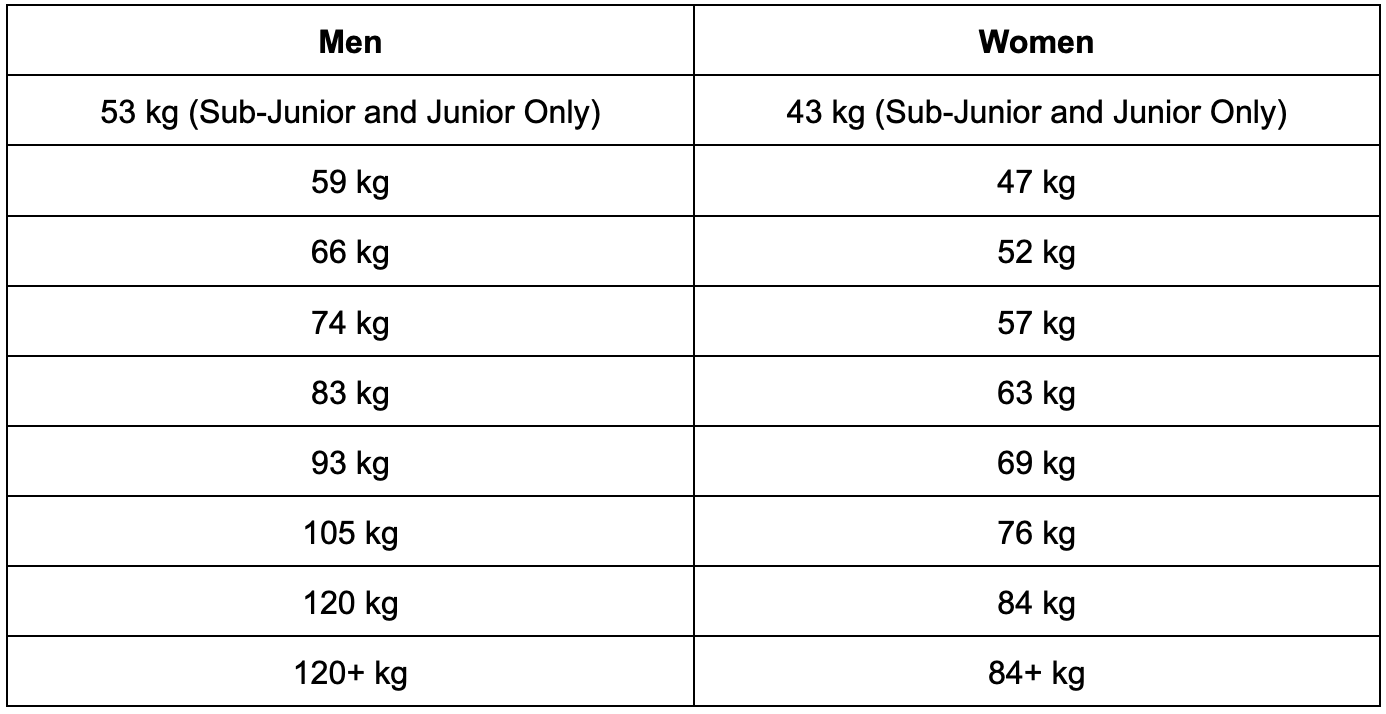
Bodybuilding Age Divisions, Weight Classes, and Height Classifications
Like powerlifting, each bodybuilding organization has its own weight classes, though some divisions only categorize competitors by height.
Different divisions also have different age requirements. But for the most part, the minimum age to compete is 18 years old, and master’s age classes range from 35+, 40+, 45+, 50+, 60+, and so on.
To give you an idea of what the height and weight categories look like, below are the classifications for the IFBB Men’s Classic Physique and Women’s Bikini divisions. The Women’s Bikini Division is based solely on height.
Men’s Classic Physique
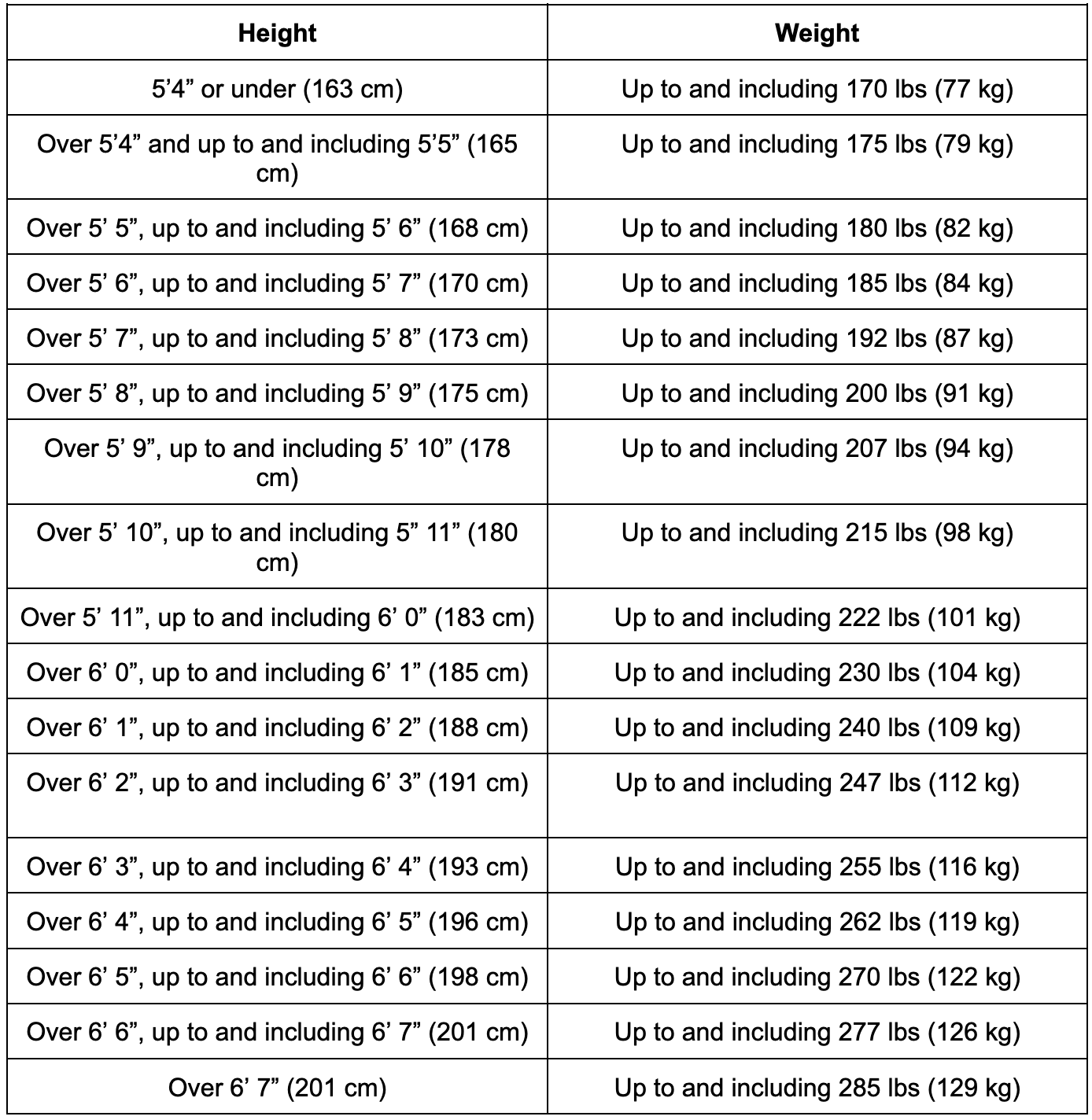
Women’s Bikini
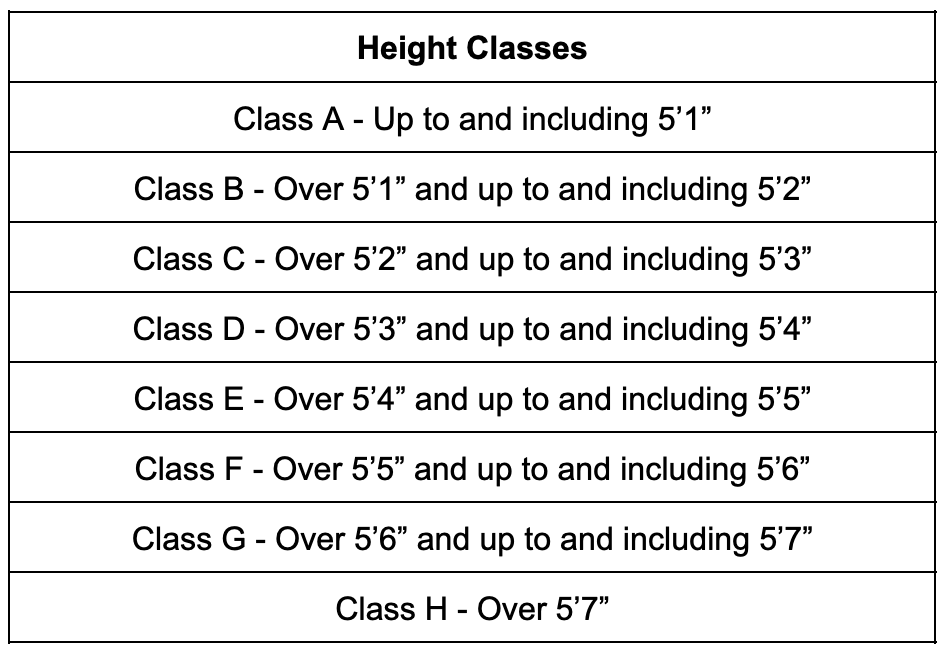
How Powerlifting and Bodybuilding Competitions Work
In a bodybuilding show, male and female competitors walk on stage and pose in various positions to show off their physiques. The judges analyze how lean and muscular an athlete looks compared to the other competitors and how balanced all of the contestants' physiques are. The judges also evaluate how well the competitors’ bodies conform to the standards of the division in which they compete. Women wear two-piece swimsuits, while men wear trunks.
At powerlifting meets, three judges watch each athlete make their attempts to ensure the athletes complete the movements to a specific set of standards. If the attempt doesn’t meet those standards, the judges will give the athletes red lights. If the attempt does meet the standards, the judges will signify a successful lift with white lights. The lifter must get at least two white lights for the attempt to count as a successful lift. All athletes were singlets, so the judges can clearly see if the lifters meet the movement standards.
Diet and Nutrition
Bodybuilders tend to be more meticulous about their diets. They have specific calorie, protein, fat, and carbohydrate targets to meet each day. As they get closer to a show, they decrease their calories so that they can appear as lean as possible on stage. During the off-season, they may go through a bulking cycle to build even more muscle mass.
Because powerlifters don't need to have optimal physiques, they don't need to be as careful about their diets. They may track their calories and macros, but they eat for performance instead of aesthetics. They may go through bulk/cut cycles to fill out a higher weight class or compete in a lower weight class, but the end goal isn't to look shredded.
Powerlifting vs. Bodybuilding Training
Powerlifters train for max strength in the squat, bench press, and deadlift. They often keep reps between 1-5 and the weight high, around 80-85% of their one-rep maxes. Many powerlifters also incorporate multiple training sessions for each lift or variations of it throughout the week. For example, a powerlifter may have two squat training sessions, one focusing on the competition squat and the other on paused squats. While powerlifters may do isolation and accessory exercises to focus on one muscle group at a time, they treat those movements as accessories to strengthen the muscles used in the three main lifts.
On the other hand, bodybuilders train for hypertrophy. They split up their training days to focus on either the upper or lower body muscle groups or dedicate certain days to specific muscle groups. For example, they may train back and biceps on Monday; chest, shoulders, and triceps on Tuesday; and legs on Wednesday. They’ll then repeat these training days and incorporate various training techniques, such as supersets and drop sets, to stimulate muscle growth and achieve their desired physique.
Bodybuilders focus primarily on isolation movements. They do compound lifts but typically use lighter weights and perform more reps and do specific variations of the squat, deadlift, and bench press that will help them develop a well-rounded physique. For example, a bodybuilder may choose to do Romanian deadlifts instead of conventional deadlifts to target the glutes and hamstrings more effectively. Additionally, they may incorporate exercises like bicep curls, tricep extensions, and leg presses to target individual muscles for maximum muscle growth.
Furthermore, bodybuilders utilize shorter rest times in between sets. This makes it easier for them to train their muscles to fatigue, which is shown to be beneficial for hypertrophy, especially when lifting light weights. (6) Powerlifters use longer rest periods because they lift closer to their one-rep maxes, which takes longer to recover from.
Exercise Technique
Because there are standards powerlifters have to follow when performing the squat, bench press, and deadlift in competitions, they will hone their technique to become proficient in each lift within the confines of the competition rules. For example, powerlifting rules dictate that the athlete must squat until the hip crease is below the top of the knees. Powerlifters will train to ensure they hit this depth every time they squat, but they won’t squat deeper than this because they don’t have to.
Bodybuilders don’t lift weights in front of judges, so while it’s important for them to lift with proper form to prevent injuries, they don’t have to adhere to competition rules. They’ll lift in a way that trains the muscles through a larger range of motion to aid hypertrophy. For example, bodybuilders will do bench presses with a narrower grip to increase the distance the bar has to travel and place more emphasis on the triceps.
Should You Train for Powerlifting or Bodybuilding?
Whether you decide to do powerlifting or bodybuilding will depend on your goals. If you want to become as strong as possible but don’t care too much about your physique, powerlifting is the better choice. If you want to look lean and muscular but don’t care about maxing out on your lifts all the time, try bodybuilding. The beauty of these types of training is that they each help you develop a foundation of strength and muscle building, and you can carry those over from one sport to the other.
Even though aesthetics isn’t the main goal of powerlifting, it can still help you increase muscle mass — you are lifting weights, after all, and that’s a precursor to building muscle. Similarly, you can get stronger through bodybuilding, especially if you progressively overload your lifts and aim to increase the weight, reps, volume, or intensity over time. Plus, bodybuilding trains many of the same muscle groups used in the squat, bench press, and deadlift.
So, if you can’t decide between powerlifting vs bodybuilding, you can always try one for a few months and see how you like it. If you’re not satisfied with your progress or enjoying your training, you can experiment with the other sport. You can also combine powerlifting and bodybuilding and do a form of training called powerbuilding. A powerbuilding program offers an effective way to train for both strength and hypertrophy because it allows you to get stronger in various compound lifts and build muscle with isolation lifts.
The Best Powerlifting Programs
Below are three proven powerlifting programs you can find free in the Boostcamp app:
TSA Beginner Approach - This is a beginner-level program that teaches new lifters the fundamentals of powerlifting and how to handle the stresses of training.
Candito 6 Week Strength Program - This intermediate program focuses on periodization, enabling you to focus on a different aspect of lifting (i.e., hypertrophy or muscular endurance) each week.
Calgary Barbell - This is another intermediate program that regularly progresses volume and intensity to ensure you keep making progress as a more experienced powerlifter.
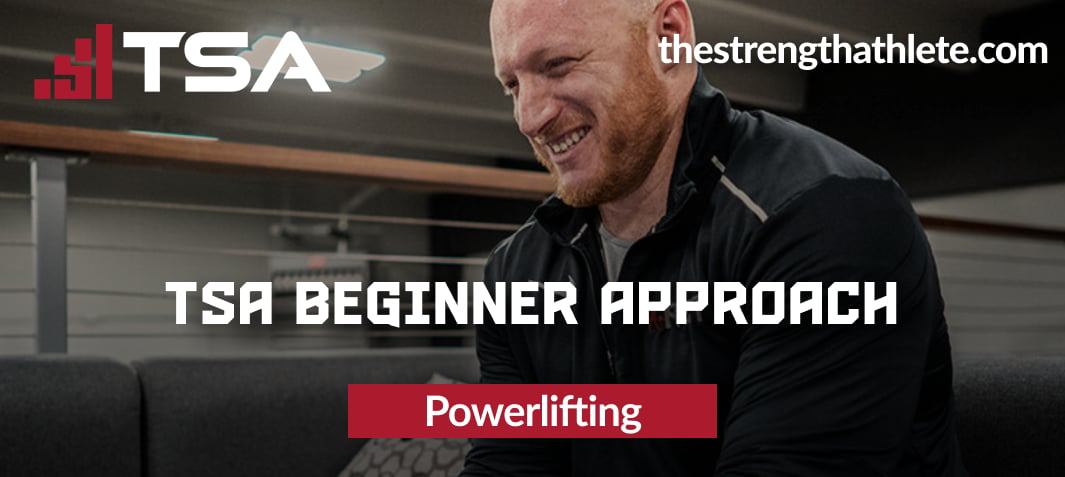
The Best Bodybuilding Programs
Below are three free bodybuilding programs in the Boostcamp app that suit a variety of physique goals
Strong Curves - This program is geared towards female lifters interested in developing the legs and glutes. You’ll do plenty of upper body training, too.
Alberto Nunez Upper Lower: This program follows a four-day split and has you training the upper and lower body muscle groups twice per week.
Dr. Swole’s PPLUL - This five-day program combines two popular bodybuilding splits: upper/lower and push/pull/legs.
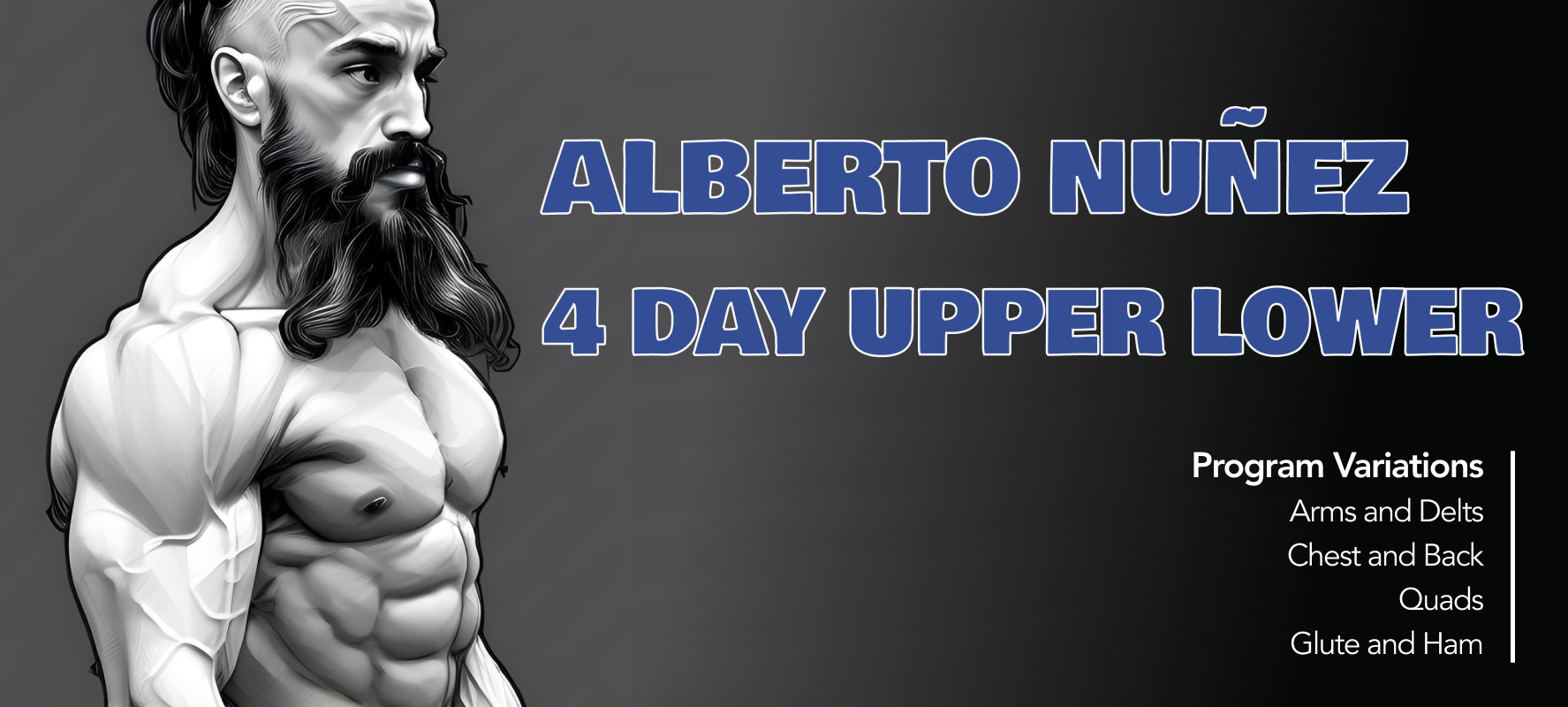
Frequently Asked Questions
Will Powerlifting Build Muscle?
Powerlifting does build muscle tissue. Even though the powerlifter physique may not be super lean, powerlifting requires you to lift heavy weights, which allows your muscles to grow. Powerlifters may not look the same as bodybuilders who train specifically for hypertrophy, but they can still grow and maintain a decent amount of muscle mass.
Is Bodybuilding Better Than Powerlifting?
Bodybuilding is not necessarily better than powerlifting. Which sport is better for you depends on your goals. If you want to lift some serious weights and be as strong as possible, you should follow a powerlifting program. If you care more about your physique and having well-defined muscles of the body, you should focus on bodybuilding.
Is Powerlifting Harder Than Bodybuilding?
Powerlifting is harder than bodybuilding in that it requires training with heavier weights and, therefore, higher intensities more frequently. However, even though bodybuilders may train with lighter weights, they typically perform more reps and train closer to failure. Bodybuilders are also more strict with their diets, including manipulating their caloric intake, which can make the bodybuilding lifestyle more challenging to follow.
Why Do Bodybuilders Look Bigger Than Powerlifters?
When comparing the powerlifter vs. bodybuilder body type, bodybuilders look bigger because they train to build muscle mass. In bodybuilding shows, judges evaluate their muscle size and overall appearance, so it’s essential that they have lean physiques with defined muscles. Powerlifters aren't as concerned with appearance, as their main goal is to move as much weight as possible. However, it is still important for powerlifters to maintain a proper diet in order to support their strength and performance. Proper diet either makes or breaks a bodybuilder's appearance, and that is why it is imperative for bodybuilders to make smart food choices.
Are Powerlifters or Bodybuilders Stronger?
Powerlifters are generally stronger than bodybuilders because they train for maximal strength, especially in movements such as the squat, bench press, and deadlift. This doesn’t mean bodybuilders are weak — in fact, many are quite strong. However, if you compare the strength levels of a bodybuilder and a powerlifter who weigh the same, the powerlifter will typically be stronger.
Can You Combine Powerlifting and Bodybuilding?
You can combine powerlifting and bodybuilding. This is called powerbuilding. It allows you to get stronger in the squat, bench press, deadlift, and other compound exercises while also building muscle with isolation movements that target one muscle group at a time.
Where to Find the Best Workout Programs
When it comes to finding some great powerlifting and bodybuilding programs, the Boostcamp App is where to go. You would want to find a program that caters to your needs and guides you in the right direction, making sure that you are making the most gains. If you are looking to stay on track and continue with linear progression, then finding a good workout program is the key. Where do you look for a good workout program? Check out the Boostcamp App for some great programs.
Boostcamp is home to over 50 FREE workout programs that consist of strength, hypertrophy, or functional fitness, or both. However, with Boostcamp, you don’t have to just follow a pre-written program, you also can create your own program as well, and track your progress to make sure you are on the right track. That being said, when you are looking to incorporate some arm training to further your powerlifting progress, then check out Boostcamp.
Be sure to follow Boostcamp on Instagram and subscribe on YouTube!
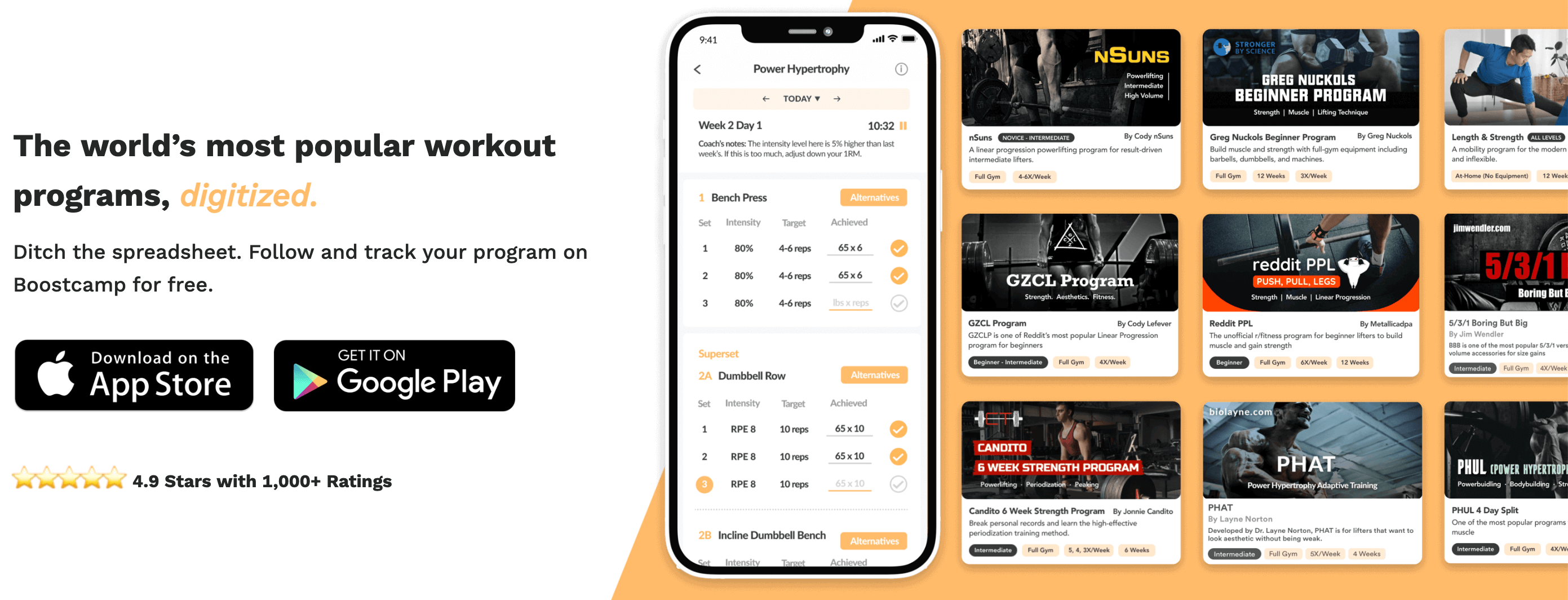
References
1. Abernathy RP, Black DR. Healthy body weights: an alternative perspective. Am J Clin Nutr. 1996 Mar;63(3 Suppl):448S-451S. doi: 10.1093/ajcn/63.3.448. PMID: 8615340.
2. Law TD, Clark LA, Clark BC. Resistance Exercise to Prevent and Manage Sarcopenia and Dynapenia. Annu Rev Gerontol Geriatr. 2016;36(1):205-228. doi: 10.1891/0198-8794.36.205. PMID: 27134329; PMCID: PMC4849483.
3. Hong AR, Kim SW. Effects of Resistance Exercise on Bone Health. Endocrinol Metab (Seoul). 2018 Dec;33(4):435-444. doi: 10.3803/EnM.2018.33.4.435. PMID: 30513557; PMCID: PMC6279907.
4. Nystoriak Matthew A., Bhatnagar Aruni. Cardiovascular Effects and Benefits of Exercise. Frontiers in Cardiovascular Medicine. 2018(5). doi: 10.3389/fcvm.2018.00135.
5. NIDA. 2023, February 9. What are the side effects of anabolic steroid misuse?. Retrieved from http://nida.nih.gov/publications/research-reports/steroids-other-appearance-performance-enhancing-drugs-apeds/what-are-side-effects-anabolic-steroid-misuse on 2023, March 28
6. Terada, Kentaro1; Kikuchi, Naoki1,2; Burt, Dean3; Voisin, Sarah2,4; Nakazato, Koichi2. Low-Load Resistance Training to Volitional Failure Induces Muscle Hypertrophy Similar to Volume-Matched, Velocity Fatigue. Journal of Strength and Conditioning Research 36(6):p 1576-1581, June 2022. | DOI: 10.1519/JSC.0000000000003690Powerlifting vs. Bodybuilding: Pros, Cons, Key Differences

